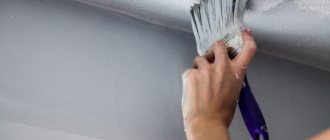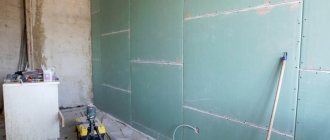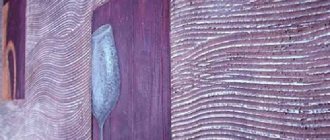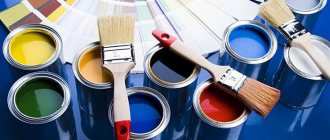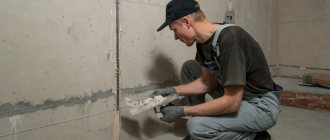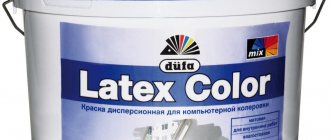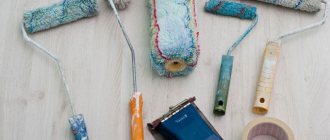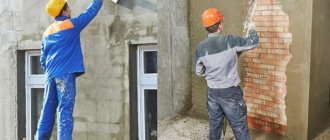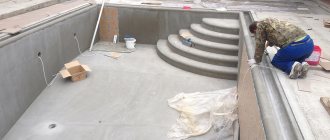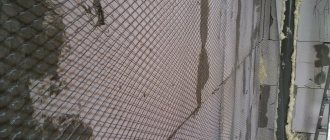- Features of plastering brick walls
- Features of concrete walls
- Features of foam block walls
- Features of wooden walls
- Optimal materials for different types of walls
Finishing a house with plaster is a classic solution in construction, used for thousands of years. Regardless of the materials from which the building is built, it is customary to use this method for finishing it. If half a century ago this method had no worthy alternatives, now there are many of them. But still, interior and exterior plaster of the house is used more often than any other technologies or materials.
Foam block, gas block, gas silicate, aerated concrete blocks, brick, concrete, even wooden structures can be conveniently treated with plaster mixtures that provide leveling and a high level of protection. Plastering a house is used outside, as well as for interior work for the primary cladding of walls, partitions, and often ceilings.
There are thousands of texts and videos on the Internet that tell you how to properly plaster wall surfaces in new buildings and old houses. But there is little information telling why such façade and interior decoration is needed and what its advantages are. When choosing between plastering walls and other options, read this article - it will answer all your questions.
Plaster and putty: differences
Without being an expert, you can get confused about the difference between putty and plastering. The technology is the same - prepare the solution, apply it to walls, ceilings or other surfaces.
But there is still a difference:
- Puttying is carried out with solutions based on gypsum (less often, other components containing only fine particles). The master uses putty to finish leveling the surfaces, which after completion of the work are smooth. Plaster is intended for rough leveling or creating a decorative effect. The fraction of particles in it is larger.
- You cannot putty the outside of the building. External putty, intended for finishing facades, exists, but it is inferior to plaster in all respects.
- You can only putty the prepared surface, and not the “bare” masonry. There is no such problem with plaster.
- Surfaces are puttied exclusively by hand, while machine plastering is a proven, effective technology.
Rice.
1. Plaster and putty There are other differences regarding the tools used in the work and other aspects. These are different, independent technologies, each of which was created for its own tasks.
Rating of plaster manufacturers
| Photo | Name | Rating | Price | |||
| The best cement plasters | ||||||
| #1 | Plitonit T1+ | ⭐ 4.95 / 5 | Find out the price | |||
| #2 | Knauf Grünband | ⭐ 4.9 / 5 | Find out the price | |||
| #3 | Weber.vetonit TT40 | ⭐ 4.85 / 5 | Find out the price | |||
| #4 | Ceresit CT 29 | ⭐ 4.8 / 5 1 - voice | Find out the price | |||
| #5 | Kreps Master | ⭐ 4.75 / 5 | Find out the price | |||
| #6 | KM Profi with reinforcing fiber | ⭐ 4.7 / 5 | Find out the price | |||
| The best gypsum plasters | ||||||
| #1 | Knauf Rotband | ⭐ 4.95 / 5 3 - votes | Find out the price | |||
| #2 | Vetonit Profi Gypsum Reinforced | ⭐ 4.9 / 5 1 - voice | Find out the price | |||
| #3 | Volma Stroy | ⭐ 4.85 / 5 4 - votes | Find out the price | |||
| #4 | Ceresit CT 35 | ⭐ 4.8 / 5 | Find out the price | |||
| #5 | Unis Teplon | ⭐ 4.75 / 5 3 - votes | Find out the price | |||
| #6 | Founds Gipswell | ⭐ 4.7 / 5 | Find out the price | |||
| The best plasters based on synthetic resin | ||||||
| #1 | Caparol Streichputz | ⭐ 4.95 / 5 1 - voice | Find out the price | |||
| #2 | Mapei Nivoplan | ⭐ 4.9 / 5 1 - voice | Find out the price | |||
What plaster would you choose or recommend?
Take the survey
Internal plaster and its differences from external
Technologically, the plastering of a house outside and the treatment of surfaces (walls, ceilings) inside the building differ little from each other. In both cases, similar actions are performed. But unlike exterior, interior plastering of walls made of brick, aerated concrete, foam block, and other materials is more demanding in terms of quality.
When performing external work, visually minor defects in terms of plane, angles, etc. insignificant. Firstly, large areas hide problems, and secondly, decorative finishing is often applied, which is used for finishing leveling.
Inside, surface treatment should be close to ideal, since all corners turn into clearly visible quality markers, uneven planes will be noticeable. Even if subsequent puttying, laying of lining or other types of finishing is expected, it is easier to decorate smooth, well-plastered walls and ceilings in such a way as to obtain a 100% aesthetic result.
Functions of plaster inside buildings
Plastering is performed both as the main finishing and as an element of preparing surfaces for the application of finishing decorative and finishing materials. Theoretically, if you plan to install roll, sheet or panel decorative materials, the walls and ceilings do not need to be plastered.
This is done because plastering allows you to solve the following problems:
- increasing the strength of structures;
- improvement of sound insulation properties;
- improved thermal insulation;
- additional moisture protection;
- plane alignment.
A “bare” wall, which is simply blocks, is unsuitable for wallpapering or painting. It needs processing. Even a small layer of plaster can be used as a surface ready for painting or wallpapering, or a base for other materials.
Standard types of plaster
Marketing in construction works well, so you can find a lot of different types of plasters on store shelves, from cheap to expensive. We will not consider the abundance of identical plasters, but with different advertising “enticements”.
Two types of plasters are popular:
- cement;
- plaster.
Cement plasters are used for leveling walls, as well as for rough work.
Cement itself is a rough material, so walls covered with such plaster do not have an ideal surface. By painting such walls, you will not get an acceptable result. Therefore, we move on to the next type of plasters.
Gypsum plasters. This solution is used for finishing work.
Gypsum is much more plastic than cement and its grain size is smaller, which allows you to achieve perfectly smooth surfaces ready for painting.
Gypsum plaster is applied in a thin layer to the walls, thereby obtaining snow-white rooms.
Advantages over other technologies
Plaster has many advantages over puttying, other leveling technologies, and rough finishing:
- improvement of heat and sound insulation;
- higher strength of the applied layer;
- minimum requirements for surface preparation;
- versatility (suitable for any walls, as a basis for applying the following materials).
Rice.
2. Plastering using a mechanized method inside the house It is also important that plastering work does not have to be done manually. It is wiser to turn to specialists in the field of machine plastering, who will complete everything in 1-10 days (depending on the area of the object), making perfectly smooth and durable walls.
Internal plaster of aerated concrete/gas silicate walls
Aerated concrete and gas silicate blocks are used for residential and non-residential construction. They have good thermal insulation and sound insulation characteristics due to their porous structure. They are light in weight, which makes it possible to get by with a lighter foundation and lighter floors, ultimately reducing the cost of construction.
Features of aerated concrete walls
Taking into account the high vapor permeability of the material, plastering of gas silicate blocks should be carried out on the basis of mixtures that have similar or similar characteristics. It is necessary that the plaster layer absorbs moisture accumulating in the air and “gives it” to the wall, which will then remove the excess outside the room.
The blocks themselves, depending on the brand, can have up to 85% of air cells of the total volume. This ensures good heat and sound insulation properties of the material. But because of them, it is loose. Therefore, when choosing plaster for gas silicate blocks, you need to pay attention to the hardness and strength of the layer that will be obtained from the mixture.
Please note: internal plastering of aerated concrete must be carried out using mortar mixtures suitable for this material. This way you will prevent the occurrence of problems associated with the negative effects of high humidity.
How to plaster aerated concrete walls
How to plaster aerated concrete inside and outside the house? The choice of materials in both cases is the same, except that for street work you need compounds with increased frost and moisture resistance. There are only a few options:
- Cement-sand mortar. Plastering aerated concrete with such a mixture would not be a good idea, since its vapor permeability is lower compared to cellular concrete. This finish is suitable for rooms with minimal humidity, which is almost never encountered in practice.
- Cement-lime mortar. These are dry mixtures that contain cement and lime, filler (sand). The most popular of them are BaumitHandPutz and Uniplast.
- Gypsum plasters. Optimal in every way. They dry quickly, experience minimal shrinkage, and do not crack when dry. Their vapor permeability is also not very high, but they are well suited for dry rooms. Such compositions can also be used in the bathroom, but only subject to subsequent special treatment of the surfaces. compositions that counteract the effects of wet environments. There are many mixtures of this type: KNAUF, Plaster and others.
How to plaster walls made of aerated concrete
Rice.
3. Mechanized plastering of aerated concrete How to plaster aerated concrete and aerated concrete block indoors? The technology is not too complicated, but with features:
- The solution must be applied to a previously prepared surface. Preparation – filling joints and local leveling. Tile adhesive is best suited for this. You can use ordinary cement-sand plaster based on M400 cement.
- To increase strength, the main layer of plaster can be applied to a fiberglass reinforcing mesh. This is good protection against the appearance of cracks during drying and during the operation of the building.
- Work can be done manually or using mechanized plastering technology, which will increase speed, but will not degrade the final quality.
- You can work in conditions of normal humidity and temperatures above 10 degrees Celsius.
- Standard tools and devices for leveling are used - beacons, rules, trowels, graters, etc.
Estimation of the cost of plastering aerated concrete walls
Plastering walls made of gas silicate blocks is a service in demand now. But it is impossible to indicate exact values for the cost per square meter of plaster. It all depends on the region, prices of the selected team, brands and cost of purchased materials. An approximate calculation is as follows: per 1 sq. m. with a layer of 10 mm requires about 9 kg of mixture, both gypsum and cement-sand.
The first material is more expensive, the second is cheaper, but is better suited for walls made of gas silicate. You can save time and money by machine plastering. The cost per square meter will be lower compared to manual application.
Review of plasters for facades and interior decoration
1. Cement-containing mineral - a budget variety, suitable for thick-layer leveling (provided it is reinforced with mesh) and forms a durable and moisture-resistant coating after hardening. PC compositions adhere well to walls and withstand significant mechanical loads; in some cases they are used as a supporting base for other brands. But at the same time, they are inferior in ductility, crack resistance, have a large weight and average permeability. The best reviews are observed for the Ceresit and Knauf brands.
2. Gypsum – quick-drying, lightweight, breathable. Due to high adhesion and ductility, they are better suited than others for finishing ceilings and inclined surfaces, and for thin-layer leveling. A distinctive feature is the short pot life - no more than 1 hour, the final strength when they harden is achieved after 1-5 days. The second feature is poor moisture resistance - you cannot plaster facades or basement walls. Knauf, Starateli, Volma, Yunis are considered trusted manufacturers.
3. Limestone – they allow air to pass through well, are easy to apply and have an affordable price. But due to their low moisture resistance in their pure form, they are practically not used; in any case, combined brands should definitely be chosen for finishing facades. There are excellent recommendations for compositions with lime additives Besto, Henkel and Osnovit.
4. Silicone ones are better than others for cladding external walls made of aerated concrete; they are valued for their resistance to dirt, moisture, UV, biological and mechanical influences, vapor permeability, lack of shrinkage and unchanged characteristics over a long service life (from 25 years). They are sold ready-made and stretch perfectly; even beginners do not have problems when applying and leveling them. The only limitation is the high cost - it is not practical to use them for thick-layer leveling or similar rough work; they are positioned primarily as finishing materials; prominent examples are Ceresit ST 174, Weber and Dufa.
5. Acrylic plasters - a diluted variety for protecting and decorating facades. Their advantages include a wide range of colors, elasticity, resistance to temperature changes and vapor permeability, while their disadvantages include an above-average price and electrostaticity. By analogy with silicone ones, they are not used for roughing and leveling work. Well-proven brands include Atlas, Weber Betonit, Baumit.
Of all the above compositions, combined (with a multicomponent binder) and pure gypsum and cement with minor additions of polymers are used for roughing and leveling. Expensive acrylic and silicone mixtures are optimal when thin-layer protection and finishing of any surfaces and facades is necessary. Only properly prepared structures need to be plastered; the quality of adhesion and the durability of the future coating depend on this.
Plastering brick walls indoors
Brick is still one of the most popular capital building materials. It is strong and durable. Masters know how to work with him, and people trust him. The only drawback compared to new porous blocks is their reduced thermal insulation characteristics, which is why brick walls often have to be additionally insulated.
Features of plastering brick walls
Plastering brick walls is a technology that has been proven over centuries. But it is also not universal - it all depends on the type of base, which can be:
- New. Working with new masonry is the easiest and most enjoyable, since minimal preparation is required and you can use different types of mixtures to choose from.
- Old. What is important here is thorough preliminary cleaning of the masonry from old mortar, repair work, and thorough priming. Plastering brick walls in used buildings is always a challenging task.
- Silicate. Typically, such masonry is smooth and even, it helps to minimize the consumption of materials. But it also has reduced adhesion, which is why it is necessary to apply the solution in two layers or use a polymer mesh for reinforcement.
Plastering brick walls is a job that allows you to not only level the surfaces, but also protect them from moisture and slightly increase the sound and heat insulation parameters of the structure.
How to plaster brick
Considering that brick is a material with almost zero vapor permeability and prone to moisture absorption, it is best to plaster it with cement-sand mortars and their modifications. However, it all depends on where and why the brickwork is plastered:
- If you need cheap, strong, durable plaster in utility rooms or a base for finishing with panel materials, it is better to use cement-based solutions.
- It is advisable to use mixtures with increased moisture resistance under tiles and in wet rooms. If you are plastering silicate or another surface that does not require leveling, you can immediately apply tile adhesive and begin finishing the walls.
- When plastering under wallpaper, it is best to use a combination of rough cement and an external gypsum layer, since the latter can be made perfectly smooth.
Without knowing exactly what to use to plaster the brick walls inside the house, consult with the craftsmen before purchasing materials. They will evaluate the object, determine the cost and recommend what is most suitable.
Rice. 4. Mechanized plaster of brick walls
How to plaster brick walls
Any experienced builder knows how to plaster a brick wall, because this is one of the basic services. The algorithm for performing the work is identical in most cases:
- Surface preparation – cleaning and priming.
- Installation of beacons, their reliable fixation.
- Applying a layer of mortar, grouting it when partially hardened.
- Final alignment.
Work is performed manually or using mechanization. There are compact machines that are used not only on large objects, but also for plastering in apartments and private houses.
Brick plastering cost estimate
The standard mixture consumption is 8-9 kg per sq. m. with a centimeter layer thickness. It can be so thin when processing perfectly smooth surfaces. Usually its thickness is 2-5 cm, which must be taken into account when calculating the amount of materials.
Work using cement-sand mortars is the cheapest; the cost is highest for gypsum and tile mixtures.
The cost of mechanized brick plastering is always lower than manual plastering.
Manufacturer's choice
There are so many brands it can make your head spin. No matter how trivial it may be, the choice should be made from well-known manufacturers. You should not get acquainted with the products of little-known companies from your own experience. First of all, plaster from the German manufacturer Knauf should come into view. This product is beyond praise, but the cost is appropriate. Do you want to choose the best and don’t know how to plaster the brick walls in your apartment? Then you should definitely choose this brand.
A large number of materials for plastering work are also produced in our country. Let’s put the “Starateli” brand in first place, followed by “Osnovit”. Next we will put “Volma”, “Yunis” and “Kreps”. Which plaster is best for leveling the walls in an apartment - the decision is yours, you have heard the opinion of the experts.
Plastering concrete walls indoors
Concrete is the basic building material. But completely concrete walls are found not in residential areas, but in underground or utility rooms. There, the primary requirements are not for decorativeness, but for protecting the monolith from moisture.
Features of concrete walls
Plastering concrete walls is needed to increase its moisture protection, since it is a material that absorbs moisture. The second reason is the impossibility of immediately applying decorative finishing to the monolith - wallpaper, putty, or painting it.
How to plaster concrete walls
All materials used for plastering concrete walls can be divided into groups:
- ordinary - for preliminary or rough finishing;
- decorative - for finishing;
- special – moisture-proof, noise-proof, X-ray-proof, sanitizing, etc.
They are also usually divided into facade, internal and universal.
If we discard highly specialized, impractical and expensive materials, there are only two types left:
- Cement-sand mixtures. The best option for pre-finishing in used premises, for leveling. Also used as a base coating in unused rooms.
- Gypsum-based compositions. More expensive, but allowing you to immediately obtain a perfectly smooth layer. This plaster is suitable for painting or wallpapering. Less suitable for rooms with high humidity.
Lime, silicate, acrylic and other specific mixtures are most often unsuitable for plastering inside the house. Or they are conditionally suitable, losing in terms of basic parameters to the above options.
Rice. 5. Plastering concrete walls
How to plaster concrete walls
Before deciding how to plaster concrete walls, you need to decide whether it should be done at all. It is not necessary to do this in a garage, unused basement, parking lot or cellar. It is enough to apply good waterproofing. In all other cases, finishing will at least not hurt, since it will increase the security and decorativeness of the structures.
Work order:
- Removing dirt, sagging, and remnants of old finishing, if any.
- Priming, preferably with penetrating compounds with moisture-proof properties.
- Installation and alignment of beacons.
- Application of the solution.
- Its alignment using a rule.
- Removal of beacons, final leveling and grouting work.
Work must be carried out at temperatures above 5 degrees Celsius, excluding strong drafts. In winter, before plastering concrete walls, you need to use air heaters or heat guns for heating.
Concrete plastering cost estimate
The advantage of most concrete monoliths is that they are smooth enough for plastering with a layer of minimal thickness. However, it should not be less than 10 mm. Consumption – within 9 kg of dry mixture per sq. m.
Mechanized plastering is cheaper than manual plastering and the work is completed faster. As for the cost of materials, you can save money by using cement. But gypsum solutions allow you to get a finished finish, so for rooms with concrete walls that will be used as living spaces, it is usually more profitable to use them.
Rating of plaster mixtures for interior work
When deciding which plasters to choose for the walls of an apartment, it is more rational to divide the space:
- dry rooms;
- to places where humidity periodically rises.
For the former, the best option is gypsum plasters. As practice shows, in the end, repairs will cost less time, effort, and money. There will be a healthy microclimate in the room, the walls will not suffocate. In addition, owners will save their nerves, since repairs are a semi-stressful state.
For the latter, it is possible to use the three types of plaster considered:
- It is advisable to use gypsum materials that the manufacturer allows for use in wet areas with protective measures taken.
- Cement mixtures (for strong bases) are used where there is a possibility of direct contact of the plaster with water.
- Cement-lime compositions can be an alternative to cement when plastering rooms with high humidity.
For a beginner, choosing plaster for facade or interior work becomes a difficult task. Choosing the right CC means creating better protection for the apartment walls for many years, providing residents with comfortable conditions, reducing in advance the possible risk of unplanned repairs, and economically managing the contents of your wallet.
Foam block plaster indoors
Foam block is a building material for walls that are not load-bearing or partially loaded. Lightweight, due to its cellular structure with clogged cavities, it has reduced thermal conductivity, providing a high level of thermal insulation of buildings.
Features of foam block walls
The surface of this material is not hard and requires additional processing even in those rooms where decorativeness does not matter. Plastering a foam block is the most logical way to protect it, and at the same time give aesthetics to the surfaces.
Functions that should be performed by plastering walls made of foam blocks:
- moisture protection;
- increased strength.
However, the last two are not critical, since foamed artificial stone is good in this regard.
How to plaster foam block
The question of whether it is necessary to plaster foam blocks if the building is built from this material should not be on the agenda. The reasons are given above. But you need to think about how to plaster foam blocks inside the house in order to get the optimal balance of strength and decorativeness.
There are two main options:
- Mortar based on a cement-sand mixture. It will add strength and provide good protection from moisture. True, it is better to choose ready-made dry compositions with increased moisture-proof characteristics. Its disadvantage is that in order to paint or wallpaper the walls you will have to putty additionally.
- Gypsum mixtures. Plastering walls made of foam blocks with them is always suitable, with the exception of the bathroom and areas for laying ceramic tiles.
But there are other, less common ways of plastering walls made of foam blocks:
- Acrylic-based mixtures. They are easy to work with, they are vapor permeable, durable, and quite strong. Well suited for use as a protective and decorative finish.
- Silicone based mixtures. They allow you to create an original decorative effect, they are also durable, with good vapor permeability.
Acrylic and silicone solutions can only be applied manually and to previously leveled surfaces. They are expensive, so they are not used often.
Rice. 6. Mechanized plaster of foam block
How to plaster foam block walls
How to plaster foam blocks indoors? The principle used is the same as when working with other types of bases: cleaning, priming, installing beacons, applying the solution, leveling it, grouting.
But knowing these nuances will allow you to get the optimal result:
- It is not recommended to begin finishing work earlier than 30 days from the date of completion of construction in order to allow them to dry completely.
- Optimal air humidity is 60%.
- The temperature range in the building is from 5 to 30 degrees Celsius.
- Drying with fans or other equipment that creates active air movement is not recommended.
- To increase adhesion, you need to plaster over a polymer mesh.
These recommendations apply to all types of foam concrete buildings.
Estimation of the cost of plastering foam blocks
The total cost per square meter of plaster consists of the costs of work and materials. The first depends on your agreement with the craftsmen, the second - on the selected materials. Considering that in most cases it is necessary to apply a layer 10-15 mm thick, it is necessary to proceed from a consumption of 0.35-0.5 standard bags of dry mortar mixture per 25 kg.
You can save on work by ordering machine plaster. With high quality and uniformity of the applied layer, the cost of processing a square meter is at least a third lower than when using manual labor.
Comparison of the most popular gypsum-based brands
When choosing plaster for leveling walls inside buildings, preference is given to quick-hardening and plastic compositions. These requirements are fully met by mixtures with minor additions of domestically produced plasticizers: Knauf Rotband, Starateli, Teplon, Volma. They have almost the same purpose; they are used for basic leveling of ceilings and walls in rooms with normal humidity. They are also united by common types of working base; they can be used to process concrete, brick and gas silicate masonry or already used gypsum or cement-sand surfaces.
The results of the comparison of characteristics are shown in the table:
| Indicator name | Knauf Rotband | Prospectors | Unis Teplon | Volma Layer |
| Consumption for a layer thickness of 10 mm, kg/m2 | 8,5 | 8-9 | 8 | 8-9 |
| Color | Grey | White | ||
| Recommended and maximum permissible layer thickness, mm | 5-50/50 | 5-50/70 | 5-30/60 | |
| Installation temperature, °C | From +5 to +30 | +10 to +30 | From +5 to +30 | |
| Solution lifetime, min | 30 | 20 | 50 | 45 |
| Drying time for a layer up to 10 mm thick, h | 72 | 24 | 120 | 24 |
| Special properties | Lightweight | Lightweight, thermal insulation | Lightweight | |
| Recommended application | Dry rooms with normal humidity | |||
The difference lies in the composition, fraction size, type of additives and quality control during the manufacturing process. Rotband has the best reviews; this brand is considered flexible and easy to apply; it adheres well to smooth ceilings, polystyrene foam boards and fiberboard. But it is also the most expensive; if you have a limited budget, you should choose another option.
Prospector gypsum plaster is positioned as lightweight, crack-resistant and permeable; its positive qualities include the ability to regulate the level of humidity indoors. It is half as strong as the Knauf analogue in terms of adhesion strength to the working base and sets faster, but is more economical. Users do not see much difference between Rotband and Prospectors, but note that counterfeits of the former are more common.
The next brand (Eunice Teplon) is recommended to be chosen if you have a limited budget, the need for wall insulation or thick-layer leveling. The latter is due to the presence of perlite in the composition; in addition to being lighter in weight, the brand has thermal insulation properties. This mixture has the lowest consumption and maximum durability; when used, even a non-specialist can plaster surfaces. Eunice Teplon takes longer to gain strength than others, but the resulting coating withstands mechanical stress better. Disadvantages noted include the risk of large cracks or the appearance of pits and grooves during the leveling process.
Volma Layer and other gypsum compositions from this manufacturer are chosen when preparing surfaces for painting, gluing thin wallpaper or applying decorative mixtures. Thanks to the small size of the fractions and polymer additives, it is well leveled, and the white color allows you to skip the stage of finishing putty. It is definitely recommended to use it as plaster for leveling walls. But the declared shelf life is not confirmed; almost instant setting is considered a serious drawback.
Features of wooden walls
Wood is an environmentally friendly, breathable material. Houses made from it have an optimal microclimate for health. But it has a drawback - exposure to moisture and high temperatures. Therefore, in such houses plaster is still used:
- In traditional wooden log houses - in bathrooms, the area where the stove and fireplace are located.
- In buildings made of timber - according to a similar principle, as well as in basements and semi-basements.
- In frame buildings, plastering and putty often become the main materials.
It is rarely possible to do without plaster at all. Even its targeted use allows you to extend the life of the building.
How to plaster wooden walls
For wood, it is best to choose quick-drying mixtures. Gypsum-based solutions are optimal. It is more difficult to work with them due to the speed of hardening, but the wood base does not have time to absorb moisture. Such materials provide sufficient vapor permeability, which also contributes to the safety of walls and partitions.
Silicone and acrylic based solutions are suitable. It is advisable to use cement-sand materials in bathrooms, toilets and where thermal protection is required.
Rice. 7. Plastering wooden walls
How to plaster wooden walls
Considering that the surfaces being treated are solid wood or wooden panels, you need to:
- Treat the base with impregnations that increase moisture resistance.
- Pre-prime all surfaces thoroughly.
- Use a polymer mesh, without which the solution will not stick to the wood.
But there is a positive point - regardless of the material chosen, its consumption will be minimal. Wooden structures are almost always perfectly level.
Estimating the cost of plastering wooden walls
Plastering in wooden buildings is a more complex task compared to buildings made of other materials. Therefore, the cost per square meter is slightly higher here. But the consumption of materials is significantly lower. Taking this into account, as well as using inexpensive machine plastering technologies, you can count on completing the work within a small budget.
Popular vote
What plaster would you choose or recommend?
Plitonit T1+
0.00 % ( 0 )
Knauf Grünband
0.00 % ( 0 )
Weber.vetonit TT40
0.00 % ( 0 )
Ceresit CT 29
7.14 % ( 1 )
Kreps Master
0.00 % ( 0 )
KM Profi with reinforcing fiber
0.00 % ( 0 )
Knauf Rotband
21.43 % ( 3 )
Vetonit Profi Gypsum Reinforced
7.14 % ( 1 )
Volma Stroy
28.57 % ( 4 )
Ceresit CT 35
0.00 % ( 0 )
Unis Teplon
21.43 % ( 3 )
Founds Gipswell
0.00 % ( 0 )
Caparol Streichputz
7.14 % ( 1 )
Final recommendations
Optimal materials for different types of walls
The most versatile are gypsum-based plasters, which are applicable in most types of buildings.
| Cement-sand | Plaster | Cement-lime | Acrylic based | Silicone based | |
| Aerated concrete | Acceptable | The best option | Acceptable | Acceptable | It is forbidden |
| Brick | The best option | Acceptable | Acceptable | Acceptable | Acceptable |
| Concrete | The best option | The best option | Acceptable | Acceptable | Acceptable |
| Foam block | Acceptable | The best option | Acceptable | Acceptable | Acceptable |
| Tree | Acceptable | The best option | Acceptable | The best option | The best option |
Manual or mechanized plastering?
Machine plastering is faster and cheaper compared to manual plastering. At the same time, the quality of work and its speed are higher due to automation of application.
| Hand plastering | Machine plaster | |
| Speed of work completion | from 10 sq.m/day | from 40 sq.m./day |
| Finishing | needed | surface ready for finishing |
| Average cost of work | 420 rub./sq.m. | 220 rub./sq.m. |
| Foam concrete plaster | Yes | Yes |
| Brick plaster | Yes | Yes |
| Concrete plaster | Yes | Yes |
| Foam block plaster | Yes | Yes |
| Wood plaster | Yes | limited |

